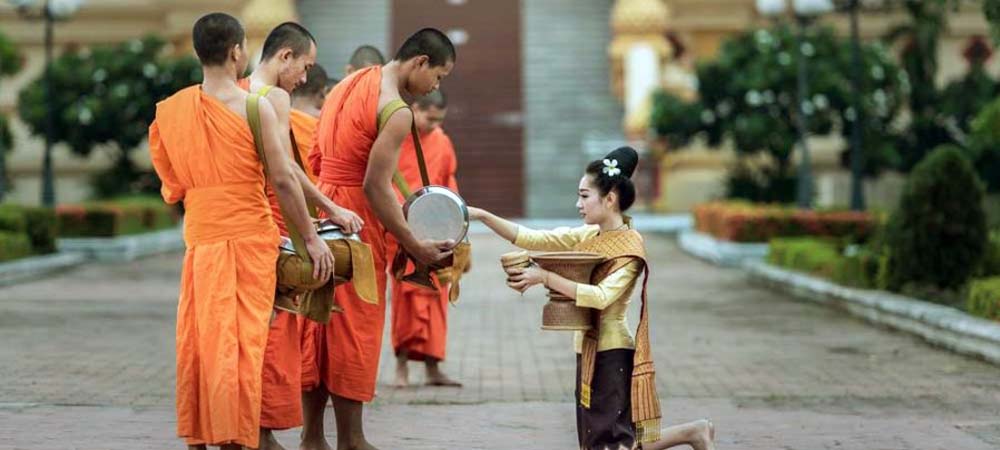Ah, Thailand. Probably the most popular Southeast Asian country for backpackers, luxury travelers and everyone in between. The capital city, Bangkok, is one of the biggest travel hubs in the region with two airports connecting countless cities to this gorgeous part of the world. While it may seem like you can’t possibly run afoul of Thai customs and traditions what with so many tourists strewn throughout the country and tolerance at a seemingly all-time high, there are certain things you can do to prepare yourself for your trip to the area with Explorient on one of our many amazing Thailand tours.
While certain customs, etiquette, and traditions can be expected, you might be surprised to learn about others. We’ve put together this useful customs, traditions and etiquette guide to Thailand to help you learn more about the things that are generally followed in this gorgeous country to help you better understand the culture and what you should and shouldn’t do.
Thailand – Etiquette, and Customs
While Bangkok can be more forgiving than smaller places throughout the rest of the country, a lot of younger travelers to Thailand unwittingly run afoul of some of the etiquettes that are generally preferred, but as the Thai people are known for their tolerance, it’s frequently allowed to carry on, with some embarrassment on the part of the locals instead. If you don’t want to be lumped into the same category as the slightly wild young’uns, consider the following bits and pieces of etiquette. You’ll get to experience Bangkok up close and personal on Explorient’s Spectacular Thailand tour.
Lese Majeste Laws
There is an extremely strict lese majeste law in place in Thailand. Lese Majeste is a French term that means “to do wrong to majesty”, or in other words, to badmouth or otherwise express negative opinions about the royal family. In Thailand, talking negatively about any member of the royal family can be punishable by lengthy prison terms. To avoid any kind of offense, avoid speaking about the royal family in any negative way, or perhaps not at all.
Feet
The soles of the feet are considered to be an undesirable part of the body and so showing the soles of the feet should be avoided whenever possible. Think in terms of sitting with your legs outstretched – especially in front of statues of religious importance such as Buddhas or Ganesha statues that can be found throughout the country. Likewise, you should avoid stepping over people who may be sleeping on the ground or stepping over the legs of those who are sitting on the ground or floor as doing so is seen as rude. Keep this in mind when traversing the country on Explorient’s amazing Thailand Explorient tour which will take you to some of the furthest reaches of the country.
The Wai
While it’s not necessary to use the Wai – the prayer pose of pressing the hands together at your heart or nose – it’s a nice gesture to say hello, thank you or goodbye. It’s also used in reverence in front of Buddha statues. A slight bow of the head in conjunction with the wai signifies more respect and is welcomed widely throughout Thailand by the locals. Get practice on your wai use during your Spectacular Far East tour with Explorient.
Mai Pen Rai
In many places in Thailand, the laid back attitude of locals can be frustrating to westerners who are used to being served or aided in shops or restaurants in a timely manner. The locals, especially in rural places (and sometimes in cities as well) are not well versed in rushing. Instead, the general attitude is Mai Pen Rai – or never mind in English. So be prepared to take it a bit slow, relax and know that it’s all part of the experience.
Sexual Tolerance
You might be surprised to know that the Thai people are some of the most tolerant in the world – especially when it comes to sexuality. The culture of drag queens, trans people and general themes of this nature are widely accepted and even promoted. Shows where so-called ‘ladyboys’ perform are popular activities throughout Thailand (but mostly in places like Bangkok or Pattaya) and it’s common to see posters, promoters and other advertising trying to get visitors to attend these shows. If it’s not your thing, a polite ‘no thank you’ will suffice when approached by promoters or performers. If it is your thing, consider taking in a show during your Bangkok and Chiang Mai Impressions tour.
Clothing
When it comes to clothing, various parts of Thailand have sometimes differing acceptance rates of clothing. What works in Bangkok may not work in Chiang Mai and what works in both may not work on the islands. It’s more likely to be the other way around, but in general, the rule of thumb is that if you’re in a rural part of the country, try to be more discreet with clothing, covering shoulders, knees and the like. Always cover up when entering temples and places of worship as it can be seen as highly offensive to enter these sacred areas in almost next to nothing (a common faux pas amongst younger backpackers). When in doubt, consider carrying a sarong or scarf to ensure you can at least cover your shoulders should you happen across a temple you want to explore but aren’t necessarily dressed for.
Temples
On the topic of temples, it’s customary and expected that shoes be removed – often before even ascending the outer stairs (if stairs are present). When encountering monks, polite conversation is often enjoyed but women should avoid touching monks or handing them anything directly as monks take a serious vow of celibacy and physical contact with women is forbidden. This is also why covering up as a woman in temples is not just encouraged, but greatly appreciated. Be sure to pack appropriately for your Thai Heritage Discovery tour.
Siesta Time
It’s important to note that some companies and businesses in Thailand do observe ‘siesta time’. For those unfamiliar with siesta time, this is a period of time, usually between about 1pm-4pm where many shops and businesses close for a respite during the hottest time of the day. It is common to see people napping at tables, chairs, in tuk-tuks and in sometimes very creative locations such as in the dirt or sand or even on the pavement.
Toilets
While Thailand is one of the most touristic countries in the area, it’s entirely likely you will happen across the more ‘local’ style of toilet at some point, especially if you venture off the beaten path or are out in the sticks. Most hotels, guesthouses and the like will have a western-style toilet, but in rural areas and older buildings, squat toilets are the primary option. Even if western toilets are present, they don’t always work like they do in the west. Be mindful of never flushing toilet paper as the plumbing and infrastructure aren’t equipped to deal with it. There will often be a bucket of water for flushing if the toilet isn’t able to be flushed as it would be in the west. In this case, you fill a smaller bucket with water and basically throw it down the toilet. Never fear – it’s actually fairly effective. The general rule of thumb with toilets is that the left hand is used for cleaning yourself and is considered unclean and the right is used for things like food and shaking hands. Don’t worry though; it’s mainly western style in Bangkok, as you’ll see on your Bangkok Stopover tour.
There you have some of Thailand’s most common points of customs and etiquette that you should follow when you’re in the country on holiday, adventuring or just exploring at leisure. There are so many great parts of Thailand that are just waiting to be explored and by following these fairly simple points of etiquette, you can ensure you have a wonderful experience, regardless of where you find yourself.





